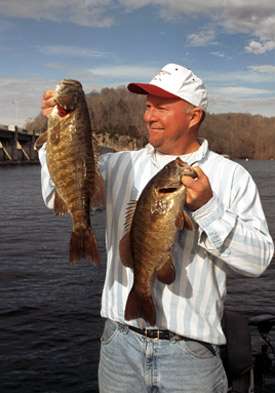
Tailspinners and blade baits are the thing when the leaves drop and the water turns cold. To learn more about how to fish them, Bassmaster.com contacted two top cold weather bassers, Stephen Headrick and Jon Bondy.
Headrick — the Smallmouth Guru — lives, fishes and makes lures on Dale Hollow Lake in northern Tennessee. Bondy, a former Bassmaster Elite Series angler, lives in Windsor, Ontario, Canada, and regularly fishes cold water. This is what they told us.
Tailspinners: Stephen Headrick
I have three ways I fish tailspinners when the water drops below 60 degrees. My favorite tailspinner, the Little Sparkie, is a lure I make here in Tennessee. It’s designed with the line tie protruding at a 90-degree angle above the body. That forces the bait to run with a slightly nose-down attitude.
Here are the ways I fish it:
1. Work it like a crankbait.
Spend some time with your graph. Locate baitfish schools and make a mental note of how deep they’re holding. Cast your tailspinner out and count it down to that depth. Hold your rod at a 45-degree angle and crank the tailspinner back towards the boat with a steady, even retrieve. If that doesn’t trigger a strike or two, drop the lure down a foot, or bring it up a foot.
The idea is to find the appropriate feeding depth and make a horizontal retrieve through it. Areas off points, over channel swings and near bluff walls are your best bet at this time of year.
2. Drop and crank the lure over the bottom.
Another retrieve that can be effective in the early winter is to let your lure fall straight down after you cast it out. As soon as it reaches the bottom, reel it up and over 10-15 feet to a new location. Don’t snap or jerk your rod. Use your reel to move the bait.
Let the bait fall back down. Repeat the process all the way back to your boat. Most of your bites will come on the fall or during the first few cranks of the reel as the lure lifts off the bottom.
3. Yo-yo the lure up and down.
Cast your lure out as far as possible and bring it back to the boat with a series of swift, sharp jerks of the rod tip. Hold your rod so that the tip is almost touching the water and then snap it straight up, as high as possible. It isn’t necessary for your lure to touch the bottom, but it should be close.
This causes the tailspinner to fall vertically with the blade whirling behind it. Most of your strikes will come on the fall.
Cold water bass can be finicky. Try all three of these techniques over the same area before you move to a new location.
Blade Baits: Jon Bondy
Blade baits are the perfect cold weather bass lure. They look and act like dying shad in cold water. I throw basic, silver models most of the time with very few modifications. All my blade baits are handmade. There are, however, any number of good commercial models available. Find one you like and fish with it.
Here’s how I fish them:
1. Fish shallow water.
Blade baits are not — or shouldn’t be — restricted to deep water. I fish mine in 3 and 4 feet of water on a regular basis. I don’t do anything fancy — just cast them out into or around a pile of rocks and then bring them back with a slow, steady lift and drop retrieve.
For this technique, spool your reel with 10-pound-test Fireline and always let the lure fall on a tight line. Bites at this time of year are subtle. You need all the help you can get.
2. Work it like a spinnerbait.
I often cast a blade bait out and simply reel it back. Again, there’s nothing fancy or secret about what I do. Bring it straight back with a steady crank of the reel handle. If that doesn’t trigger a strike, try snapping it or maybe letting it fall a foot or so.
But remember that the water is cold. Baitfish are lethargic; in fact, many of them are in the process of dying. Anything moving fast at this time of the year looks unnatural because it is unnatural.
3. Don’t try to match the hatch.
This is not the time of year to match the hatch with size or color. Half-ounce silver blade baits work just fine. If bites are few and far between, try a wacky or unusual color, but only if you have no other choice. Fishing blade baits is about location and reaction, not creativity.
One concession I do make from time to time to matching the hatch is adding a small piece of prism tape to the side of the lure. It adds flash as the lure vibrates in the water. That duplicates the flash shad have when the sunlight strikes their sides. For obvious reasons, this is most effective on sunny days.
These techniques will work anywhere when the water’s cold. They are truly universal. Give them a try this winter.




